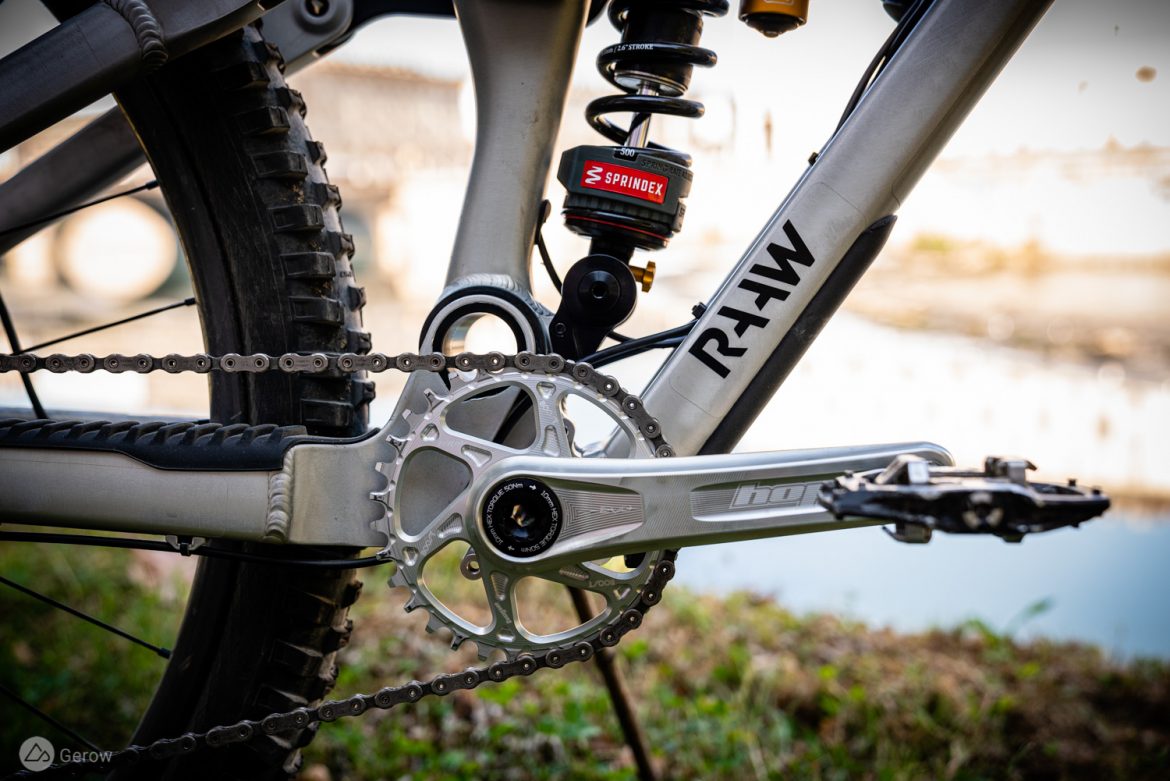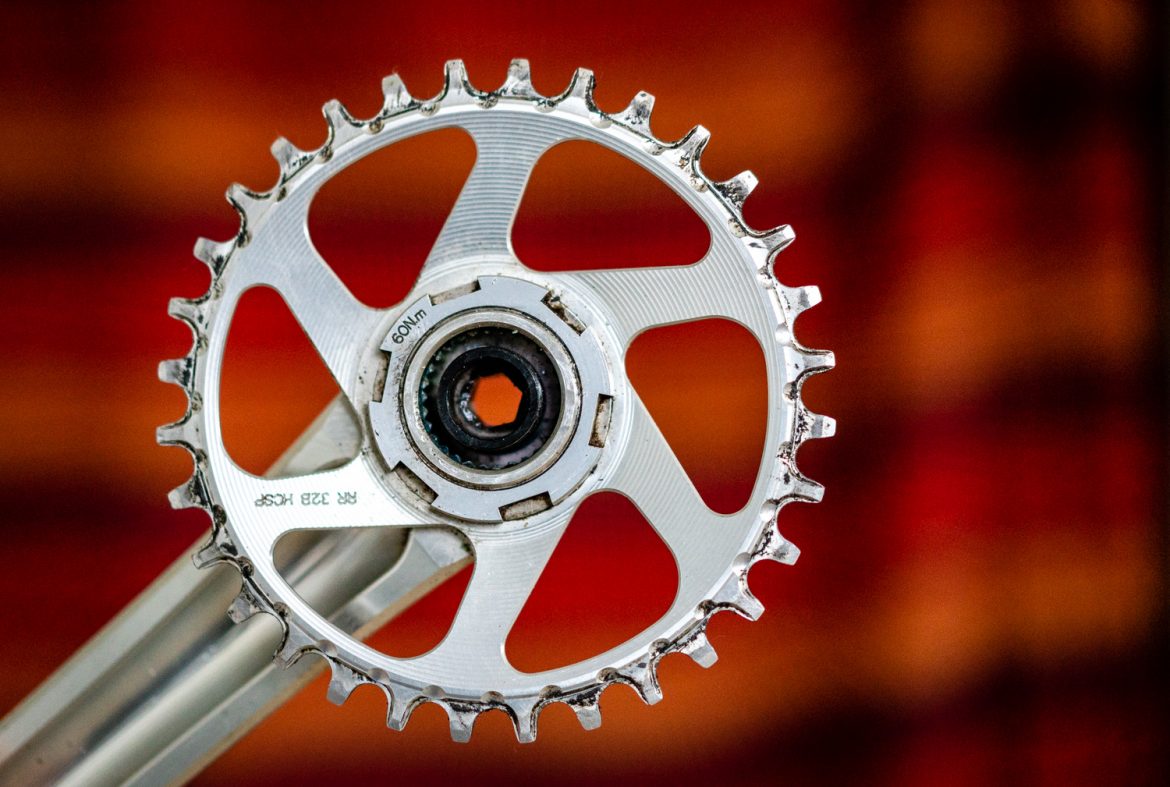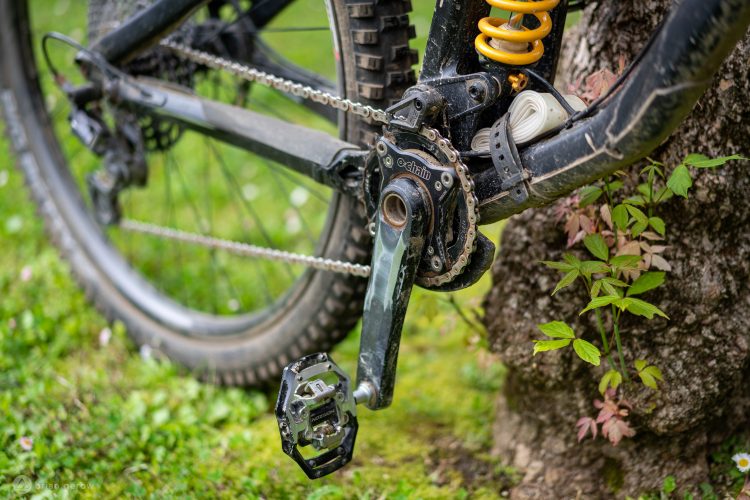
A well-shaved set of forged and CNC’d alloy cranks can look pleasingly like a pair of bionic femur bones with an angry circle attached to one hip. I’ve always appreciated this aesthetic connection. Femurs are strong and cable bones. These alloy EVO cranks and chainring from Hope are every bit as tough as they appear, and I’ve enjoyed banging them into things over the past few months to ensure they’re more than just a pretty finish.
The EVO crank arms are made from 7075 aluminum, and the husky 30mm spindle is 7150 alloy. Arms come in 166, 170, and 175mm lengths with black, blue, red, silver, purple, and orange anodization. They can accommodate XC, DH, and fat bike standards, and Hope also has a new SuperBoost version. I tested the 166mm length to pair with the extra-low BB on this Raaw Madonna, and I’m happy to report that my legs adapted to the 10mm shorter crank length with zero complaints. The shift was un-notable enough in terms of pedaling that I can only comment on the reduced pedal strikes, an appreciated change.

The Hope external bottom bracket uses a proprietary spline tool that I don’t own, but that’s nothing that an adjustable channel lock wrench and a little patience can’t fix. When installing a BB with the big-kid-pliers it’s important to only squeeze the teeth as much as absolutely necessary so you don’t deform the cups. At 40-50Nm of torque, there’s little need for a clicky wrench. “As tight as you can get it” has always worked quite well for installing threaded bottom brackets.
With the BB properly greased and snug the cranks slide together like any other. I mounted a 32t chainring, tightened the lockring, wiped marine grease on all of the parts that touch each other, and slid the spindle into place. The bearing tolerance is fairly tight, but there’s no need to bust out the hammer to insert this crankset. The non-driveside crank is attached to the spindle out of the box, and the driveside tightens into place with a 10mm hex key. One upside to the spindle being attached to the non-drive crank arm is that you can typically pull the driveside arm to clean or replace the chainring without removing and readjusting the chain guide. With both crank arms installed, crank down the non-driveside preload adjuster until it’s snug and lock it into place with the single screw. Then, go pedal.
The large set of bearings in that 30mm BB are running as smooth as ever after a few months of deeply-dusty riding followed by daily mud spins and washes. I wouldn’t expect anything else from a UK brand, and it seems that this BB is a good choice for soggy PNW pedaling.

Given my slight body size and minuscule sprint capacity, I can’t say much about the stiffness of these cranks. They feel every bit as stiff and responsive as any other alloy or carbon crank I have used, and I would likely have to produce twice the watts to feel a noteworthy difference. I can say that they take a legit beating from the stones below without issue. I have banged these cranks into countless rocks while climbing, and thankfully fewer when trying to squeeze in another pedal stroke into a fast turn, and the sturdy alloy all looks safe and clean. For a lot of riders, stone strike tolerance is more important than stiffness, and the Hope EVO cranks are up for a flogging.
I didn’t test these cranks with a chain guide because I wanted to see how well the ring teeth keep their grip between the plates. I have yet to drop a chain with the Hope ring and haven’t experienced any other drivetrain issues to date. I’m able to backpedal in any gear without binding or derailment.
On dry rides, the ring remains silent and gains some crunchy-munchy sounds in heavier mud like any other drivetrain component. The crunchy song seems to start a little earlier with this ring which may be due to the same tight tolerances that provide great chain retention. Fortunately, those noises don’t seem to affect performance and the chain doesn’t drop when I backpedal in the mud as it has with other rings. The teeth clear mud and loam reasonably well, and they are undoubtedly durable. Thanks to poorly timed bunny-hops and nose-bonks, I have rammed the chainring into a number of rocks and logs and all 32 teeth remain properly aligned.

The important aspects of a crankset and BB are durability, chain retention, and a lack of noise. This Hope EVO set has been creak-free throughout testing, and I’m confident it will hold up for several seasons to come. Priced at $365 (available at Wiggle), plus roughly $70 for the chainring (available at JensonUSA and Performance), this crankset is on par with others in its league. For an additional $130 the longevity and rebuildability of the Hope BB is undoubtedly worth the coin. At about 540g in 165mm length, these cranks weigh a touch more than the XTR set we tested a few summers ago, and they’re also a little less expensive.
⭐️ The Hope EVO crank set is sold at Wiggle. Compatible chain rings can be found at JensonUSA and Performance.
Party laps
- Easy to install
- Versatile system to fit a variety of bike types
- Great chain/tooth interaction
- Good color and length selection
Pros and cons of the Hope EVO Crankset.
Dirt naps
- Ya still have to pedal























3 Comments
Nov 16, 2021
Nov 16, 2021
Nov 16, 2021